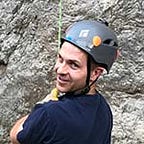Why I wear a rock climbing helmet
I know this can be a controversial topic among rock climbers. Wearing a rock climbing helmet flies in the face of the quintessential spirit of rock climbing. No rules, no boundaries, no brakes, and no cares. Why would you try to protect yourself in such a ridiculously crazy sport as rock climbing anyway?
While this isn’t meant to be a guilt trip for anyone not wearing a rock climbing helmet, I don’t see many good reasons not to wear one.
I personally don’t clip into a rope outside the climbing gym without a rock climbing helmet on. I also don’t put my car in drive without putting on my safety belt. Am I likely to need it to keep me safe? Probably not. But I don’t want to be caught without it at my own or someone else’s expense.
When rock climbing, you work as a team and if one member of the team chooses to not wear a rock climbing helmet and is injured, the other members of the team suffer consequences. Not only do I not clip myself into a rope without a helmet on, but I don’t let anyone belay me or climb while I belay them without a helmet.
Every year people make fatal mistakes while rock climbing in both tame and wild places. Little errors, simple oversights and lack of preparation can turn risk into real, life and death danger.
Here are a few scenarios that may convince you to wear a rock climbing helmet.
Rockfall
If you haven’t experienced rockfall yet, just wait. It happens. It’s terrifying when it does. Even small rocks can become lethal projectiles and if you’re lucky enough to not get killed on contact or get knocked unconscious, even a small rock to the face is enough to cause a belayer to lose control of the rope and drop a climber straight to the deck. Often, belay stances are tight and there’s not much room to move out of the way of a falling rock or shower of rocks. With a helmet on you can shield your face from the rocks and let them hit your helmet instead.
You may think you’re safe since you only climb at well-traveled sport crags that don’t have much lose rock. A lot of single pitch sport crags have walkoffs where people are coming and going, setting topropes, and generally not paying attention to other climbing groups. There can also be more beginners or kids at crags like this. A stray rock, or even a thrown rock — yes, I’ve seen kids throw rocks off the top of a wall — could easily come hurtling down at you without much warning while you’re chilling out barefoot with no helmet or shirt on. You’ll likely never even hear “rock” called out. Gear like belay devices or carabiners also get dropped and these can be just as dangerous as falling rocks.
Hitting your head while climbing
You could flip around in the air and get tossed upside down. Or, you could peel off during a hard move that puts you in a horizontal position. One bad fall could send your head right into the wall.
A head injury is bad no matter where you are, but halfway up a route, the situation becomes more serious. Help may be hours away if you climbed up a long approach. A helmet gives you more protection from making it on the nightly news after a life flight rescue.
Rock climbing helmets don’t just protect your head if you fall. If you’ve climbed for any significant period of time, you’ve likely hit your head on an overhang as you ascend. These bumps usually aren’t enough to do serious damage, but I’ve hit my head hard enough that without a helmet, I would have been knocked pretty good and had a hard time finishing the route.
Fortunately, my rock climbing helmet hasn’t taken any critical hits yet, but each time I look at all the scratches on it, I think how that would be my head if I didn’t have a helmet on.
Climbing is a team sport
Keeping your climbing partner or team safe is probably the best reason to wear a climbing helmet. Even if you don’t care about your own skull, you should care about your friend’s safety.
(Read this article on how to belay.)
Imagine that you’re belaying your partner when a rock comes loose and hits you in the head. If you don’t have head protection (a rock climbing helmet), your partner’s in trouble.
You’ll likely let go of the rope and drop your partner. On top of the risk to your partner, they now need to find a way to descend to you while you are presumably unconscious and bleeding out of your skull. Yeah, good thing you didn’t put that lame helmet on, right?
If you want to read some real horror stories about climbing incidents involving helmets — or the lack thereof, visit Petzl’s #HelmetsMatter page here.
(Learn more about rock climbing here.)
Conclusion
Rock climbing isn’t a good way to die or become disabled. Anyone who’s climbed long enough knows someone who’s experienced a life-changing incident or died from their injuries. Wear a helmet to reduce your risk and protect people you climb with from becoming injured as a result of you not doing what you can to stay safe.
It’s not worth $60, looking dumb, being a bit uncomfortable, a bit of extra gear to carry, or any other reason. It’s simple to wear a helmet so just do it! Of course, I won’t tell all you free-spirited rock climbers what to do 😉
If you have a different perspective or opinion, I’d love to hear about it in the comments below.
Originally published at https://myadventureschool.com on August 13, 2019.
